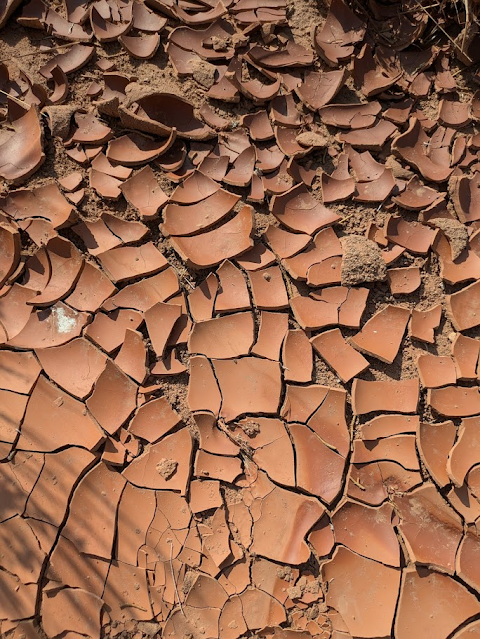On a recent visit to the high desert region of Northeast Utah with my eldest grandchild, I had the opportunity to hike alone into the red-banded hill region of the desert west of Vernal. Koda was busy at the field station museum in town and I had the morning to explore. Hot and dry and at altitude, a mile was all I could manage as an out-and-back, and with no one knowing where I was, I didn't want to take chances so I kept this little excursion short. Fully hydrated with a text message sent (but not acknowledged) with my location, I followed the hiking and single-track Lapointe Trail favored by mountain bikers. I could see the path flow up and around flat-topped hills of red sandstone and wished I'd had rented a bike! Named the Corkscrew Trail, it was one of two loop trails that make up the Lapointe Trail system near Lapointe, Utah.
 |
| Sagebrush |
The scent of sagebrush filled the air and with every step a cloud of red dirt dust swirled in the slight breeze. I looked for pottery sherds in the wash and found a few, left in place but sketched into my sketchbook as I went. Most were grey clay but one little piece had the black and white pattern so familiar to desert dwelling peoples of centuries ago. I admired the small artifacts where they lay and considered how the desert itself is an artifact of expired inland seas and of contemporary imaginings of the desert environment. This place checked the box for stereotypical desert, but of course all deserts are ecologically, geologically, and culturally different from each other.
 |
| Mud-crack in a wash |
I watched a little Whiptail Lizard wriggle-run her way across the bike tire tread tracks and into a shady hole. I studied her tiny trail thinking I'd found a real treasure only to look up to see a dozen baby Whiptails racing here and there, chasing flies, scurrying beetles, and big, fat Harvester Ants. They were everywhere all at once. Imagine them the size of a small Allosaurus, traveling in a herd like this. I wouldn't stand a chance!
 |
| Whiptail Lizard tracks |
I had only gone a half mile before I realized that there were no landmarks to navigate by, except to look back over my shoulder to see the rental truck parked in the distance at the trailhead. Everywhere else I looked, north, south, west - all looked the same. The same sagebrush flats, the same flat topped hills, the same red dirt, the same smoke-hazed horizon. The ages and ages of sameness of this place, its thousands of years of head-splitting heat and bone jarring cold, flat, tedious, dusty - it made me feel very small indeed. Like a grain of red sand. I felt like I had been out here for a million years, yet it had been less than an hour.
 |
| Prickly Pear Cactus |
I wandered down the broad wash to look for more sherds when a mountain biker appeared out of nowhere pushing his carbon-framed bike down the single track and looking totally pissed off. I met him later in the parking area at the trailhead waiting for a ride to the trailhead miles away where he'd left his car and his extra tubes and patch kits. "Bloody cactus!" he said, smiling wryly. He looked like a god that had jumped out of a cliff carving, a petroglyph warrior wearing his head dress helmet and armored plastic shin protectors.
This is the Hour of Land, when our mistakes and shortcomings must be placed in the perspective of time. The Hour of Land is where we remember what we have forgotten: We are not the only species who lives and dreams on the planet.
There is something enduring that circulates in the heart of nature that deserves our respect and attention.
Terry Tempest Williams from The Hour of Land: A Personal Topography of America's National Parks
Notes:
Steven Simms, (2016) The Fremont Period https://historytogo.utah.gov/fremont-indians/
Terry Tempest Williams (2016) The Hour of Land: A Personal Topography of America's National Parks




No comments:
Post a Comment